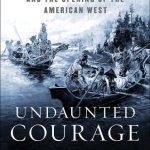
The Crossing by Donna Jo Napoli and illustrated by Jim Madsen (Atheneum Books, 2011) is a creative retelling of the Lewis and Clark journey, as told from the perspective of the infant Jean Baptiste strapped on the cradle board on Sacagawea’s back. Brilliantly illustrated pictures of the various North Western American landscapes and careful descriptions of the sounds, animals, and textures a young toddler would have experienced provide a compelling version of a historic journey.
Given the young child’s perspective, there is not a lot of fact until the Author’s Note describes the Lewis and Clark expedition, giving a little more context. But for the young student of Lewis and Clark, Jean Baptiste’s account of the journey provides enough setting, trial, and curiosity to bring the subject alive on a preliminary level. The Crossing is a wonderful picture book of a true event.



